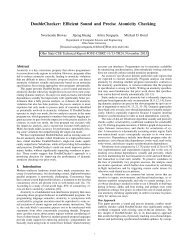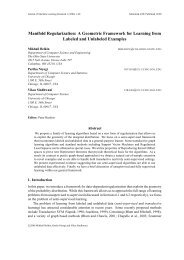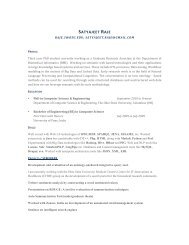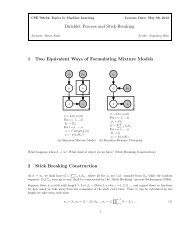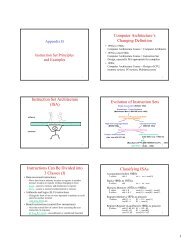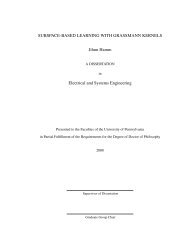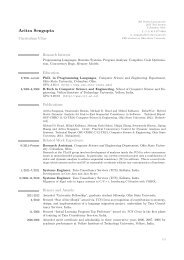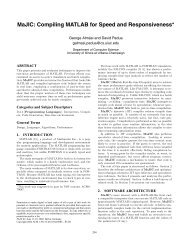Approximation Algorithms for Embedding General Metrics Into Trees
Approximation Algorithms for Embedding General Metrics Into Trees
Approximation Algorithms for Embedding General Metrics Into Trees
You also want an ePaper? Increase the reach of your titles
YUMPU automatically turns print PDFs into web optimized ePapers that Google loves.
Figure 2: An example of a tree-like decomposition of a graph.<br />
Initially, K G is empty. Let t be the maximum index such that V t is non-empty. Let Y i = ⋃ t<br />
j=i V j. For<br />
each i ∈ [t], and <strong>for</strong> each connected component Z of G[Y i ] that intersects V i , we add the set Z ∩ V i , to the<br />
partition K G . Observe that some clusters in K G might induce disconnected subgraphs in G.<br />
TK G can now be defined as follows. For each K,K′ ∈ K G , we add the edge {K,K ′ } in TK G iff there is<br />
an edge in G between a vertex in K and a vertex in K ′ . The root of TK G is the cluster containing r. The<br />
resulting pair (TK G, K G) is called a (r,λ)-tree-like decomposition of G.<br />
Figure 2 depicts the described decomposition.<br />
Proposition 1. T G K<br />
is a tree.<br />
Proof. Let u,v ∈ V (G). Since G is connected, there is a path p from u to v in G. Let p = x 1 ,... ,x |p| .<br />
For each i ∈ {1,... , |p|}, let K i ∈ K G be such that x i ∈ K i . It is easy to verify that the sequence {K i } |p|<br />
i=1<br />
contains a sub-sequence that corresponds to a path in TK G. Thus, T K G is connected.<br />
It is easy to show by induction on i that <strong>for</strong> i = t,... ,1, the subset L i ⊆ K G that is obtained by<br />
partitioning ⋃ t<br />
j=i V j, induce a <strong>for</strong>est in TK G. Since L 1 = K G , and TK G is connected, it follows that T K G is a<br />
tree.<br />
3.1 Properties of Tree-Like Decompositions<br />
Be<strong>for</strong>e using the tree-like decompositions in our algorithms, we will show that <strong>for</strong> a certain range of the<br />
decomposition parameters, they exhibit some usefull properties.<br />
We will first bound the diameter of the clusters in K G . The intuition behind the proof is as follows. If<br />
a cluster K is long enough, then starting from a pair of vertices in x,y ∈ K that are far from each other,<br />
and tracing the shortest paths from x and y to r, we can discover the <strong>for</strong>bidden structure of lemma 1 in G.<br />
Applying lemma 1 we obtain a lower bound on the optimal distortion, contradicting the fact that G embeds<br />
into a tree with small distortion.<br />
Lemma 2. Let G = (V,E) be a graph that γ-embeds into a tree, let r ∈ V (G), and let (T G K , K G) be a<br />
(r,γ)-tree-like decomposition of G. Then, <strong>for</strong> any K ∈ K G , and <strong>for</strong> any u,v ∈ K, D G (u,v) ≤ 20γW G .<br />
Proof. Assume that the assertion is not true, and pick K ∈ K G , and vertices x,y ∈ K, such that D G (x,y) ><br />
20γW G . Recall that K G was obtained by partitioning the vertices of G according to their distance from r.<br />
Let q x , and q y be the shortest paths from x to r, and from y to r respectively. Let K 1 ,...,K τ be the branch in<br />
T G K , such that r ∈ K 1, and K τ = K. By the construction of K G , we have that <strong>for</strong> any i ∈ [τ], <strong>for</strong> any z ∈ K i ,<br />
D G (r,z) ≤ iW G γ. Thus, D G (x,y) ≤ D G (x,r) + D G (r,y) ≤ 2τW G c. Since D G (x,y) > 20γW G , it<br />
follows that τ > 10.<br />
Consider now the sub-path p x of q x that starts from x, and terminates to the first vertex x ′ of K τ−2<br />
visited by q x . Define similarly p y as the sub-path of q y that starts from y, and terminates to the first vertex y ′<br />
5




